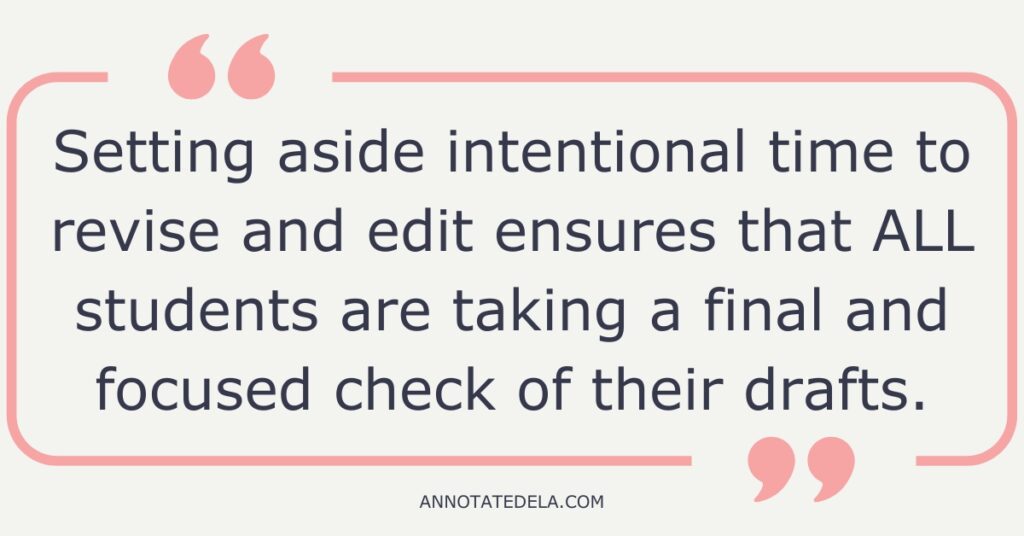Narrative Writing Process: A Guide for Effective Classroom Instruction is a continuation of Narrative Writing: A Step-by-Step Guide for Success in Middle School and How to Teach Narrative Writing for Powerful Classroom Instruction In those blog posts we explored the first six steps in a narrative writing unit. In this post we will explore the final three steps in a narrative writing unit.
This blog post and the series of blog posts that follow are designed as a comprehensive guide, crafted with the middle school classroom in mind. Whether you are a seasoned educator seeking fresh ideas or a novice teacher eager to embark on this writing adventure, this guide will equip you with the tools to guide your students towards becoming proficient storytellers.
Download the Narrative Scope and Sequence for a detailed guide on how to guide students through the narrative writing adventure.
Writing Workshop & Conferences in the Narrative Writing Process
After students have written their fast draft, step six in the narrative writing process, it’s time to jump into writer’s workshop and conferences.
Writer’s workshop includes writing, check-ins, feedback, and mini-lessons. The check-ins and feedback are considered conferences. This time is some of the most important time of the narrative writing process.
Start each workshop day with a mini-lesson on a specific element of narrative writing, and then give students time to use what they’ve learned.
As students write, use this time to conference (check-in and provide feedback) as they work.
Over time the fast draft will turn into a well-developed story.
Some ideas for mini-lessons:
-Hooks to engage the reader
-Strong endings
-Transitions
-Dialogue
-Figurative language
-Descriptive writing
-Tone and mood
-Word choice
The mini-lessons are lessons that will benefit student writing.

Revision and Editing in the Narrative Writing Process
Some students will revise as they draft, revision may be part of an ongoing narrative writing process. Editing may also be done while drafting, many students are ‘fixing’ spelling and punctuation as they progress through the writing process.
Yet, some students (most students) take a one-and-done approach to writing. These students want to write the first draft and publish it.
Setting aside intentional time to revise and edit ensures that ALL students are taking a final and focused check of their drafts. This time should be for guiding students through self and peer revisions with clear guidelines and expectations.
The revision and editing process is most simple when focusing on one element at a time and working through it in stages. This can be incorporated into mini-lessons if it feels right.
For example, have students circle verbs and descriptions before replacing them with more vivid ones or have them highlight transitions and determine if they show a transition in time, place, etc. Spending time to set and model expectations is essential for productive revision time.
Finally, I save the editing, the mechanics of their writing, for last. We are more focused on bettering their writing before the mechanical side of it.

Celebrate Published Work in the Narrative Writing Process
The students have worked hard and put forth effort to complete the narrative; now it’s time to celebrate.
The writing and their hard work deserve to be celebrated and shared, not just turned in to sit in a “to be graded” pile.
Get creative and have fun when planning a publishing party.
Publishing party ideas:
-Have students choose excerpts of their stories to read – if doing this, decorate the room like a coffee shop or a glow party to make the reading feel special.
-Do a gallery walk of stories. Students can have the typed versions pulled up on computers, or hard copies can be posted around the room. Invite other adults in the building to visit and read. Have sticky notes for people to leave glowing comments
-Make a story poster or story wall and have students display a summary or one pager of their story.
-However you celebrate, make it work for you and your class.
While there may be students who did not finish, take time to celebrate the students who made it and completed the narrative. This can become a reward for finishing because students who did not finish will have to spend the celebration time completing their narratives.
Reading a boring story is the worst, but grading one feels even more challenging. A well-planned unit will engage students and be fun for everyone.
With any idea, take this information and make it your own. Make the adjustments you and your students need for the narrative writing process.
Looking for more ideas on how to teach narrative writing? Checkout the two previous blog posts, Narrative Writing: A Step-by-Step Guide for Success in Middle School and How to Teach Narrative Writing for Powerful Classroom Instruction in this series of blogs on the narrative writing process for the first six steps in a narrative writing unit.




One Response